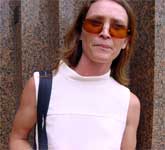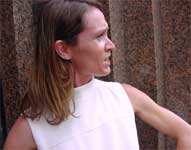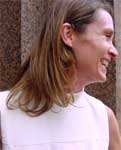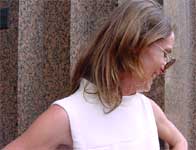Sarah Runcie January 2002.
Cornered: In Conversation with Lea Lennon




�Je suis l�espace o� je suis.� I am the space where I am. - as quoted from Bachelard's Poetics Of Space
It is one of those muggy Sydney days. The sky is swollen with impending rain. The air is thick, sluggish. Dipping past oblivious city drivers and equally oblivious tourists, Lea Lennon, art director, graphic designer, titles designer and animator, is bounding down George Street, looking impossibly cool in her elegant cream, simple cut, dress.
�Today I thought I�d go the sac.� Lea lets out a big and boisterous laugh that seems to roll out from the soles of her feet to the top of her head. If you don�t know Lea, it can be quite disconcerting to get such a big sound from someone so slight of build. What she laughs at is anything �wanky�, overly-self-conscious or absurd. Lea will tell you she is firmly anti-wank. Which, of course, begs the question how she ended up in the film industry.
Beginning her interest in art at an early age, (�I had always drawn.�), Lea�s first love was photography and illustration. �One of the first books I was given when I was really young was a book of photography by David Hamilton - you now girly twat stuff.� Lea busts with laughter over her mother unknowingly giving her the book. (�Very prudent of her!�) However, it wasn�t until visiting the graphic design studio owned by the father of a fellow high school student, that Lea�s interest really developed.
Floating in through the air conditioned comfort of the MCA at the �Other Pictures� Exhibit, Lea points out the fundamental paradox of the curatorial theme: �[the photographs] are all amazing�they say something distinctly personal. They�re not anonymous at all.�
Paradox certainly appeals to Lea's own sense of creative process, or as she calls it "the rhizomic rollercoaster". Despite being rarely out of work, the ad industry left Lea somewhat frustrated: �I was often criticised for being too left of field while working in the ad industry�The mistake in the ad industry is to underestimate the intelligence of the audience.� But the eighties were an interesting time, "a period of excess.�
Musing on the image of a half blind man against the backdrop of some mid-west American town that has undergone some terrible natural calumny, leaving telegraph and power lines wonky and houses flattened, Lea muses on the 'punctum' of the piece. Is it the man's bandaged face that you can't help read in relation to the disaster zone around him? Is it the crack and loopy angles of the broken telegraph poles? Is it the men in the middle distance staring into the camera back at us with that mysterious, concentrated gravity of the old photograph, as though it was the photographer that was the spectacle, not themselves. More than likely, it is not what you would expect as a dominant feature in these accidental and amateur compositions.
Drawing on Barthes' writing on the image, Lea has an interesting take on the definition of the 'punctum' as "the essence of a captured moment in time." And yet, rather than being the paradigmatic metaphor or metonym, Lea nearly always returns to that point in the photograph that seems to sit outside the unifying impulse of the meaning system. The 'punctum' is less essential and closer to the irreducible, that which subtly undermines neat interpretation.
It is no wonder that Lea's own work has tended toward the 'left of field', the avant-garde and why the ad industry was, after ten years of professional work, so "stifling". Film, however, "just opened so many more doors." For Lea, there was so much more opportunity to explore interesting visual representations of idea.
Having worked on everything from a Showtime feature to "Heartbreak High" to "The Matrix" to short films like Catriona McKenzies' "The Third Note", Lea's experience is nothing if not broad. As an art director, Lea sees the challenge as conveying character, spatially, visually, within a glimpse of screen time: �We�re looking through a window at a woman, we don�t know anything about her. Rather than just do the room with all the standard fixtures, I would take a bookcase and fill it with milk bottles�to show obsession.�
On obsessions of her own, Lea says she is obsessed with interior design, obsessed with architecture and obsessed with Bachelard's Poetics of Space. Before starting any art directing or set design, Lea starts with her favourite chapter about corners: "[Bachelard] defines the simplicity of basic structure. He defines the intimacy in a corner, the mystery in a drawer and that for me translates on a structural level�I find the poetics of his work leads very strongly into, even when you are drafting or thinking about a space, the characters in the script�He brings me back to a really basic level at the drafting stage."
Staring at a photograph of a couple, circa 1940's, presumably a GI and his sweet heart, one of the figures has their face carefully carved out, erasing individuality, Lea admits that she wants to know the story. "Did they hate one another? Was it love? I want these images explained with a story." For me, looking at the result of that seeming midnight and ambiguous act, I get a strange sense of voodoo, of lost lives.
Story, the psychological direction of a scene, deeply informs Lea's sense of design. It is the basis of the collaboration with director and art department. It is the first thing that Lea reacts to, script to script, project to project.
As a titles designer, the process of seeking the essence of an idea is even more rigourous. Titles design is a "finely tuned art" whereby you have a minute or 30 seconds, or even less, to set up or undermine audience expectation. As a much ignored aspect of film design, at least within the popular imaginary, most movie goers with any interest in short film or Australian features would have seen Lea's outstanding work with out even knowing it. For Lea, the secret to a great title sequence is how you convey a central idea and the timing: "It's all about timing."
Surprisingly, Lea does not collect art. "I really enjoy, like a blank page, having a very clean space for me�[it] allows me to think uncluttered." However, Lea does have favourite home objects: "I have a great relationship with my fridge. It's my harbour bridge. It's my best friend. And it's my canvas because I actually do draw and paint on my fridge. Does home-made food count as an art object?"
However, Lea does have one prized ceramic work by Cybele Rowe which she describes as "voluptuous". "I bought it about fifteen years ago for as much the idea behind it as the object itself." Entitled 'I found a piece of gold inside me', Lea says that as an object, it represents her belief that everybody has a 'piece of gold' inside them.
At end of interview, Lea bounds out of the MCA into the drizzle of a summer afternoon still looking impossibly cool in her cream 'sac'. I follow her rhizomic path through the tourists and commuters into middle distance.
Page design
© Jayne Waterford: email ARTnews. 2002